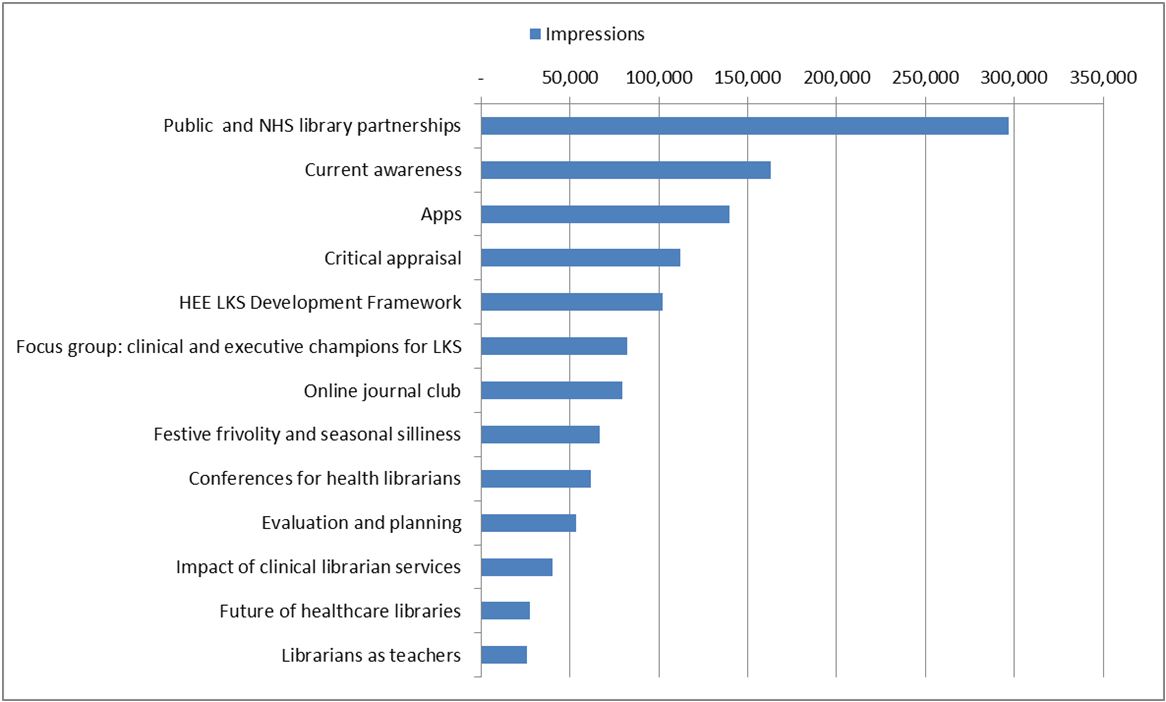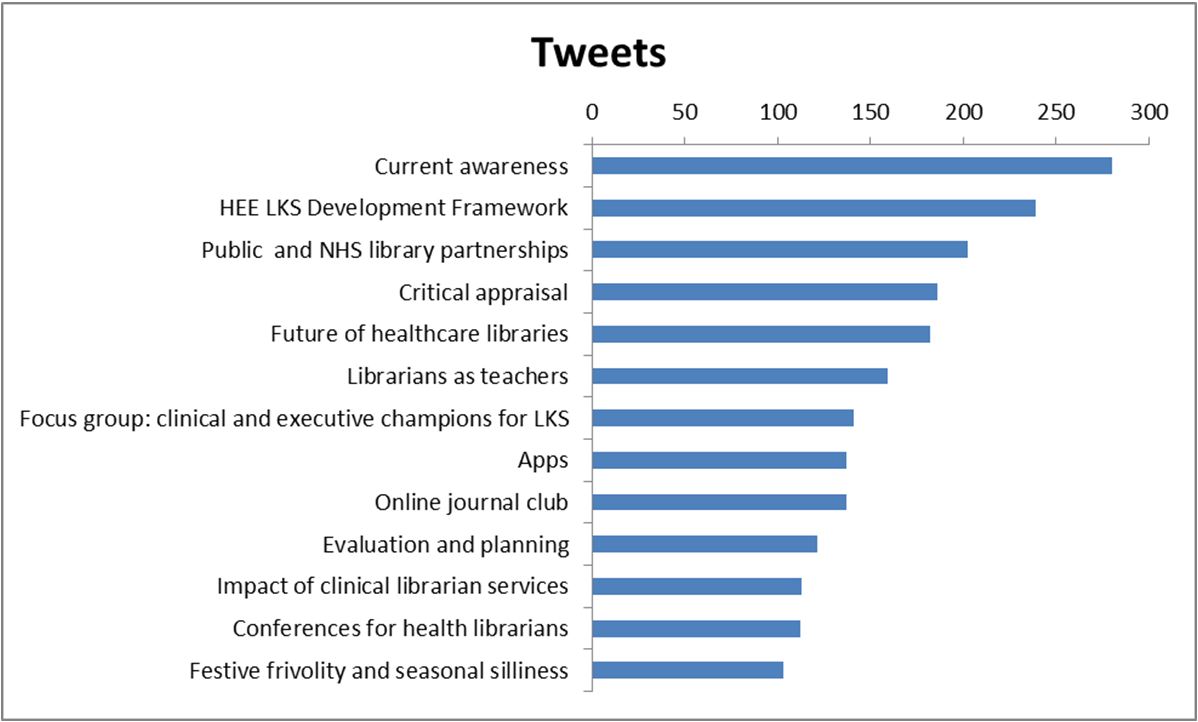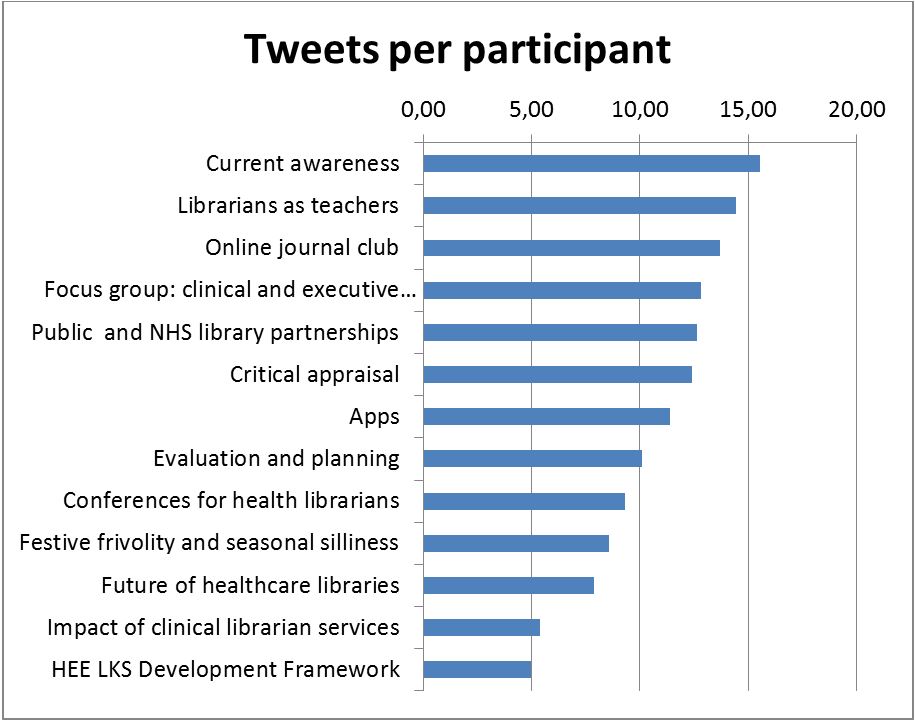1Brighton and Sussex NHS Library and Knowledge Service, Brighton, UK.
2Great Western Hospitals NHS Foundation Trust, Swindon, UK
3Surry and Sussex Healthcare NHS Trust, Redhill, UK
Corresponding author: Tom Roper, tom.roper@bsuh.nhs.uk
Introduction
In recent years, Twitter chats have developed as a medium for professional development, networking and exchange. Inspired by the example of the North American #medlibs chats, in May 2015 the authors started the monthly #ukmedlibs chats, on the third Tuesday of each month at 8 pm. At the time of abstract submission, the chats had received over a million Twitter impressions. Archives of chats are kept on symplur.com
Objectives
The presentation will describe how Twitter chats function, discuss progress to date and assess, by means of user evaluation, the usefulness of Twitter chats as a medium for professional development. By the time of the conference we will have the archives of fourteen chats to draw on.
Methods
Chat archives will be analysed, and sources and themes identified. Participants will be asked to evaluate the chats, and offer examples of its impact, through a Twitter focus group and an online survey.
Discussion
The advantages and constraints of online real-time discussion using social media will be analysed and their implications for librarians’ professional development, networking and exchange assessed.
Conclusions
The presentation will share the lessons learned and conclude by asking if Twitter chats on a pan-European basis might be viable.
Keywords: Social media; Twitter; Education, Continuing; Professional Development; Organizational Innovation; Social Networking
Introduction
The social networking service Twitter has grown in its ten years of existence to 310 million active monthly users (March 2016)(1). Twitter chats, regular scheduled conversations on Twitter, with set agendas and questions, have become a regular feature of the medium. The Symplur(2) website, set up to support health Twitter chats lists 202 recurring chats, while in Britain the wecommunities(3) site lists 16 for nurses, doctors and other health professionals.
Librarians have been active users of Twitter since its inception, and have taken up the Twitter chat for professional networking and development. Our North American colleagues have run a regular chat using the hashtag #medlibs(4) since 2012 and, while many of us would read the transcripts with interest, time differences meant active participation in chats was difficult, as they take place at 02:00 UTC. The #medlibs chat has produced the only contribution to the professional literature on the use of Twitter by health librarians to date, Ford(5).
In Britain the library-related chats in have included the #chartership chat for candidates for CILIP chartership, #radlibchat from the Radical Librarians collective and #uklibchat, which discusses general issues of concern to the profession. The authors noticed the absence of a British chat for health librarians and, with the guidance of Nikki Detmar, convenor of #medlibs, and in liaison with existing British chats, to avoid clashes and duplication, conceived the idea of a British chat. We asked a British medical librarians’ e-mail list, lis-medical, if there would be interest in such a chat. Responses were positive, and the first chat took place in May 2015.
Methods
Chats take place at 20:00 in the evening on the third Tuesday of each month. To participate, users log in to Twitter and follow the discussion. Users are asked to tag all their contributions with the #ukmedlibs(4) hashtag, so others can see the whole conversation, and for archiving purposes. One of the team, the three authors of this paper, or a guest, acts as chat leader and facilitator or leaders will use the ukmedlibs blog to set out an agenda and questions around the theme of the chat. Questions are numbered and participants encouraged to use these in discussion, to help organise the discussion. At the beginning of the discussion we encourage participants to tweet a short personal introduction.
Topics for chats are determined by the team, with suggestions from participants and key contacts in leadership positions in the professions. To date twelve chats have taken place on the following themes:
- The Health Education England Library and Knowledge Service Development Framework (May 2015)
- The future of healthcare libraries (June 2015)
- Twitter journal club: a journal club conducted around Rethlefsen(6) (July 2015)
- Health and public libraries partnerships (August 2015)
- Conferences (September 2015)
- Librarians as teachers (October 2015)
- A Twitter focus group on clinical and executive champions as advocates for library and knowledge service(s November 2015)
- Festive frivolity: an exchange of bizarre articles from the biomedical literature in the style of Improbable Research (December 2015)
- Critical appraisal (January 2016)
- Do you have an ‘appy library? Apps for clinicians and librarians (February 2016)
- The impact of clinical librarian services (7) (March 2016)
- Current awareness services
- Now we are one: a focus group on the chats themselves
Symplur provide analytics and transcripts of the chats, which are posted to the ukmedlibs blog. Data was extracted from these and analysed to rank chats by impressions, numbers of participants, the number of tweets during the hour of the chat and the tweet-per-participant ratio, which we hypothesised would measure the intensity of activity during a chat. Apart from the count of impressions, these data do not tell us about those who watch a chat without intervening; similarly, we have no data on those who may not participate in a chat but may read the transcript at a later date.
The May 2016 chat was devoted to evaluation, and the transcript analysed to provide qualitative data on the value of the chats and to inform their future direction
Results
Since the first chat in May 2015, tweets with the #ukmedlibs hashtag have received 2,005, 862 impressions (Symplur, 3 June 2016). 2,928 tweets have been posted with the hashtag by 276 accounts.
Figures 1- 4 show ranked results of the twelve chats by impressions, numbers of participants, the number of tweets during the hour of the chat and the tweet-per-participant ratio
Figure 1 Impressions

Figure 2 Number of participants

Figure 3 Number of tweets

Figure 4 Tweets per participant

In a facilitated evaluative chat in May 2016 participants identified a number of strengths of the chats. Chats were felt to offer valuable continuing professional development (CPD) opportunities, and several said they had used participation as evidence to meet professional accreditation or revalidation requirements. Participation in an hour’s chat once a month for a year would give at least 12 hours, two-thirds of CILIP’s requirement of 20 hours activity to revalidate. Another pointed out that with 261 participants over the year (figure correct at the time of the May chat), the chats reached many more people than could be accommodated at most conventional face-to-face CPD events.
Participants also cited the wide range of topics discussed as being a positive feature engaging different sections of the health library and knowledge service (LKS) community. The informal nature of chats was valued, ‘there’s also the fact that one can have a mouthful and still participate’, said one, ‘unlike conventional meetings, where speaking with one’s mouth full is frowned upon’ observed another. Timing was controversial. Chats in working hours were not felt to be viable, since potential participants would not be able to be released from their duties, and, moreover, at some hospitals Twitter and other social media platforms are blocked. Participants valued the provision of transcripts, which allowed them to catch up on discussions if they had been unable to take part at the time. Some identified the impact of the clinical librarian and the journal club sessions as being particularly useful. The phenomenon of the ‘lurker’, who watches the discussion but does not participate, concerned some, but others felt that people might lurk at first until they felt prepared to participate actively. One participant felt it would be helpful to know who planned to participate in advance, something that could be accomplished by tweets to that effect using the hashtag.
Suggestions for future chats were made, including:
- Chats about particular sectors, such as public health, mental health or primary care
- Advocacy within organisations, and using Knowledge for Health’s advocacy toolkit
- Engaging with clinical teams
- The public libraries universal offer for health (and the universal offers more generally)
- Knowledge for Healthcare one year on
- The Knowledge for Healthcare leadership programme
- Knowledge Management (KM) in health
- Chats around CILIP conference (Brighton, 12-13 July) and HLG conference (Scarborough, 15-16 September)
Discussion
We note that different measures show different topics as the most popular. While the chat on public and health library partnerships scored the most impressions, the first ever chat on the Health Education England LKS Development Framework (8) had highest number of participants, while the current awareness chat recorded the highest number of tweets, and the highest ratio of tweets to participant, which, we suggest, might be an index of the intensity of activity of a chat.
We would suggest that the Twitter chat has proved itself as a means of supporting CPD. While numbers of participants in any one chat are not large, a total of 276 unique participants over twelve months bears comparison with many more conventional CPD events. The workload of organising and supporting chats is not inconsiderable, and new recruits to the organising team would be welcome.
The results we report are open to selection bias. Those who do not find Twitter chats helpful or do not use Twitter of necessity do not take part. We would suggest therefore that Twitter chats are one form of CPD activity among many.
We would hope that participants with a reasonable command of English from any country would find the chats hospitable. While the choice of topics so far often reflects the English or British context, many are international in scope. We would welcome wider participation in the chats or, if colleagues wish to establish a pan-European chat, would be happy to offer our experience to support them.
The authors would like to acknowledge the assistance of Nikki Detmar, convenor of the #ukmedlibs chat, Symplur for providing archives and analytics, Louise Goswami, John Blenkinsopp and Alison Brettle, guest chat leaders in November 2015, January and March 2016 respectively, and, above all, the 276 participants in chats over the past twelve months.
- Twitter. Twitter: Company: About 2016 [updated 31/03/16; cited 2016 3/6/16]. Available from: https://about.twitter.com/company.
- symplur.com. Healthcare Tweet Chats: @symplur; 2016 [cited 2016 03/06]. Available from: http://www.symplur.com/healthcare-hashtags/tweet-chats/.
- WeCommunities. We Communities 2016 [cited 2016 03/06]. Available from: http://www.wecommunities.org/.
- #medlibs chat 2016 [cited 2016 3/6]. Available from: http://medlibschat.blogspot.co.uk/.
- Ford C, Tolmie D. Breaking the Limits of Time and Space: How Twitter is Helping #medlibs Collaborate and Communicate. A Descriptive Study. Journal of Hospital Librarianship. 2016;16(2):116-31.
- Rethlefsen ML, Farrell AM, Osterhaus Trzasko LC, Brigham TJ. Librarian co-authors correlated with higher quality reported search strategies in general internal medicine systematic reviews. Journal of clinical epidemiology. 2015;68(6):617-26.
- Brettle A, Maden M, Payne C. The impact of clinical librarian services on patients and health care organisations. Health information and libraries journal. 2016;33(2):100-20.
- Knowledge for healthcare: a development framework. London: Health Education England, 2015

